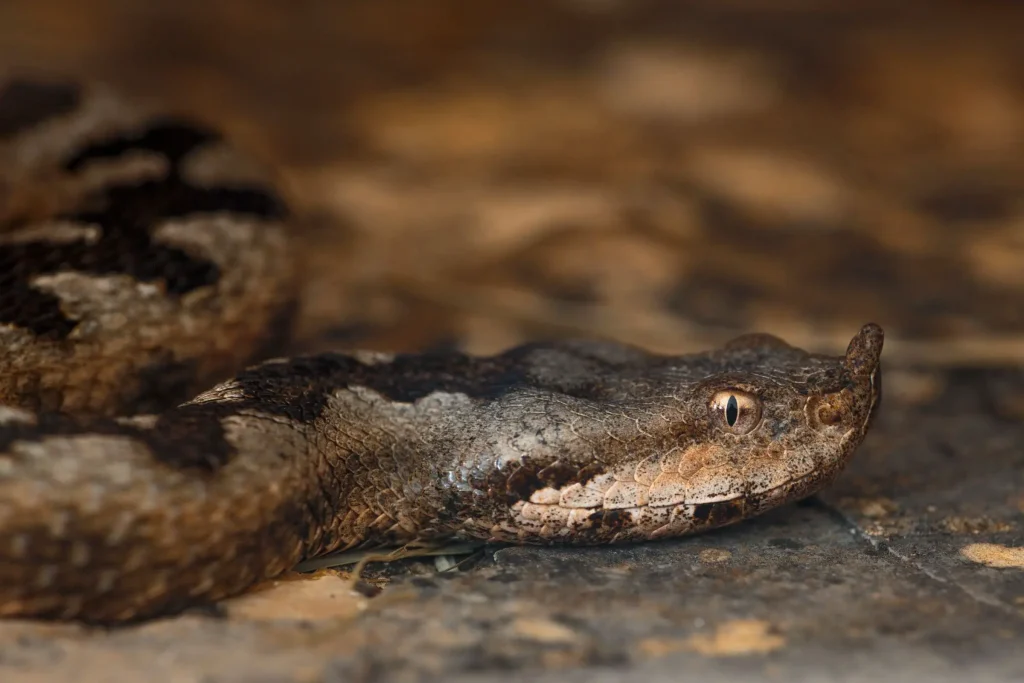If cornered, surprised or in fear, they can and will take a swipe at you. If you see a snake, especially a horned viper, make sure to give it a wide berth and show it some respect. You’ll likely get the same back and you’ll both merrily go on your way. Here’s what to do if do find yourself hiking out in the Dalmatian mountains and happen to sit or step on a snake.
As Poslovni Dnevnik writes, the weather is hot, summer is here, and people are (when not begging for mercy under their air conditioners), spending and more time out exploring nature, hiking, and going to the beach. Some things need to be kept firmly in mind during this time of year, writes N1, and one of them is that Croatian snakes are also out looking for their places under the sun, and they have every right to do so. The Croatian Institute of Public Health has announced what to do in case you do get too close to a snake and how to protect yourself.
Snake bites
There are 14 species of snake living in and around Croatia, of which only three are venomous, the horned viper (Croatian: poskok), the Common European viper/adder (Croatian: ridjovka), and the Meadow viper (Croatian: planinski zutokrug). Although the distinctive horned viper is slightly more venomous than the Common European viper and the Meadow viper, all three of these snakes are less venomous and as such less dangerous than, for example, African or Asian venomous snakes, and their bite is very rarely fatal.
The horned viper (poskok) is ash-gray in colour and grows up to around one metre in length. The head is heart-shaped, with a characteristic ”horn” on the tip of its nose, from which it draws its rather ominous-sounding name. Along the spine of this snake there is a dark winding line that goes from the head all the way down to the tip of the tail and is characteristic of every viper. There are dark spots running along the side of this line. The horned viper lives mainly in the southern, more rugged Croatian regions.
The Common European viper (ridjovka) is found throughout Europe. It is about 60 to 80 cm long and also has a zigzag line running along its body. There are two species: Vipera berus bosniensis and Vipera pseudoaspis.
If you are bitten by a snake, the most important thing is to determine whether it is venomous or not. Unlike non-venonous snakes, venomous snakes have a triangular head and narrow elliptical eyes. Croatian snakes who are venomous also differ from non-venomous ones in the shape of their bodies, which are short and stocky, in contrast to non-venomous snakes whose bodies are thin and elongated. It should be noted, however, that distinguishing venomous snakes in this way is valid only in Europe and for native European species.
Species from the Viperidae family from North and South America and Asia, such as rattlesnakes, also have a depression between their eyes and nostrils that are used to detect heat. However, European species from the Viperidae family do not have such indentations, so this cannot serve as any sort of criteria for distinguishing venomous and non-venomous snakes in our climate.
When it comes to self-help procedures, it is stated that a bitten individual should absolutely not try to find and seek revenge on the snake. Snakes do not bite out of malice and should not be harmed. Seeking out an irritated or frightened snake again may lead to an additional attack. If the snake is found and killed, which, once again, should absolutely not be done, then it is preferable to bring the body to the hospital with you for accurate identification.
At the bite site, two puncture wounds from the snake’s teeth are usually visible, and they’re around 6-8 mm apart, although it is possible that there is only one wound or even just a small scratch. The finding of a wound doesn’t mean that the venom was injected into the body. According to data, as many as 22% of proven bites have no signs of venom within them.
Symptoms of a snake bite
Pain and swelling appear at the bite site typically occur within two hours. In severe cases and where a lot of venom has entered the body through the wound, the pain appears quickly and is unusually sharp; the swelling also spreads quickly and may be accompanied by severe subcutaneous bleeding. Along with redness, blisters with bloody content may appear on the skin.
Immediately after the bite, almost half of those bitten experience general symptoms such as dizziness, nausea and vomiting, an overall feeling of weakness and swelling of the regional lymph nodes (this can also occur in and around the groin in the case of a bite in the leg, or in the armpit in the case of a bite in the hand). Pale and cold skin, profuse sweating, a rapid heart rate and drop in blood pressure are signs of shock, which generally develops gradually and is the main cause of death.
Snake bite procedures
If the snake you’ve been bitten by is not venomous, the wound should be washed very well with water, smeared with antibiotic ointment and wrapped with a clean bandage. It should be checked when the person who was bitten was last vaccinated against tetanus, and if more than five years have passed, a booster vaccination is required.
If you’ve been bitten by one of the venomous Croatian snakes, the person must remain absolutely still, the slightest of movements should be avoided, and the arm or leg with the bite wound should be immobilised as quickly as possible. Do not try to suck out the venom from the bite site. Any compression of the wound must be performed by specially trained healthcare professionals in extraordinary cases.
It is necessary to take the bitten person to the hospital immediately. In principle, every case of a person being bitten by a snake sees them hospitalised, without thinking too much about whether the snake is venomous or not.
Antidote for snake bites (antiviperinum) comes from horse serum, and contains antibodies that the horse produced after being injected with snake venom. Antiviperinum is given only in hospital conditions intravenously, and only when strictly indicated, since the antiserum itself can cause serious and even life-threatening reactions.
Snake bite prevention
Some snake bites, such as when a person accidentally steps or sits on an unsuspecting and understandably rather disgruntled snake, are almost impossible to prevent. However, there are precautions that can significantly reduce the chance of being bitten by Croatian snakes this summer:
– Leave any snake you might come across minding its own business completely alone. Many people get bitten when trying to kill a snake or get as close to it as possible. This is cruel and absolutely not necessary. You are invading the snake’s territory and it, like all animals, should be respected. If you want to take a photo or a video of the snake, do so from further away and use your zoom feature! Snakes usually try to avoid you entirely, and only very rarely do they decide to attack. If a snake bites you, you can almost guarantee that you are the one who has caused it.
– Avoid tall grass and plants if you don’t have suitable footwear on (thick leather boots) as Croatian snakes enjoy lying around and hunting their prey there, and use existing paths as much as possible.
– Do not put your hands or feet in places that cannot be seen or inspected properly for any potential threat (for example, don’t put your hand in a bush or behind a rock or stone). Do not pick up rocks or pieces of wood unless you are far enough away from a potential snake attack. All of these locations are enjoyed by Croatian snakes, including the horned viper and the Common European viper.
– Be especially careful and prepared if you’re into rock and mountain climbing. Croatian snakes are, like all others, cold blooded, and enjoy lying on heated rocks to provide them with energy. They aren’t fans of being disturbed by climbers and hikers.
– Dogs and cats (and other animals) are just as susceptible to being fatally harmed by a bite from a venomous snake. If your pet is bitten, take them to an emergency vet immediately for treatment. Do not allow your pet to approach a snake under any circumstance. Curiosity killed the cat, and in this case it will kill the dog too.
– Croatian snakes have no interest in you whatsoever, show them the same grace and don’t tempt fate.
How many fatal bites have there been in Croatia so far?
“In the last twenty years or so, only three cases of a snakebite being fatal have been recorded in Croatia, in 2006, 2007 and 2013, they occur sporadically with an average number of cases of 0.2 per year for the analysed period, and the counties in which the cases occurred in Zadar, Split-Dalmatia and Lika-Senj counties”, they stated from the Croatian Institute of Public Health.
Most of the victims who died from bites from Croatian snakes were adults. The absolute number of recorded deaths from this cause is small, so it can only be concluded that cases of deaths caused by Croatian snakes are extremely rare. Men are more often victims of snake bites than women. The most recorded bites were from the Common European viper (ridjovka), which is the most widespread venomous snake in Europe.
For more, make sure to check out our dedicated lifestyle section.









